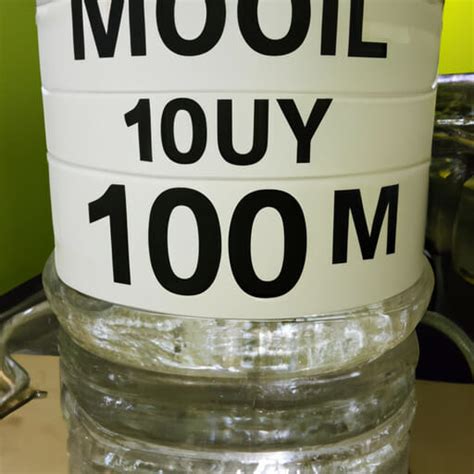How Many Liters In 100 Oz
Kalali
Apr 06, 2025 · 4 min read

Table of Contents
How Many Liters are in 100 Ounces? A Comprehensive Guide to Unit Conversions
Understanding unit conversions is crucial in various aspects of life, from cooking and baking to scientific research and engineering. One common conversion many encounter involves ounces (oz) and liters (L), particularly when dealing with liquid measurements. This comprehensive guide will delve deep into the conversion of 100 ounces to liters, exploring the methods, providing precise calculations, and offering helpful tips for future conversions.
Understanding Ounces and Liters
Before diving into the conversion, let's briefly understand the units involved:
-
Ounces (oz): A unit of volume commonly used in the United States and some other countries. It's important to note that there are fluid ounces (fl oz) used for measuring liquids and avoirdupois ounces (oz av) used for measuring weight. When dealing with liquid measurements, we always use fluid ounces.
-
Liters (L): A metric unit of volume, widely used internationally. It's part of the International System of Units (SI). One liter is equal to 1000 cubic centimeters.
The Conversion Factor: The Key to Accuracy
The cornerstone of any successful unit conversion is the accurate conversion factor. The conversion factor between fluid ounces and liters is approximately:
1 fl oz ≈ 0.0295735 L
This means that one fluid ounce is roughly equal to 0.0295735 liters. The "≈" symbol indicates an approximation, as the conversion is not an exact whole number.
Calculating 100 Ounces to Liters
Now, let's apply this conversion factor to determine how many liters are in 100 fluid ounces:
100 fl oz * 0.0295735 L/fl oz ≈ 2.95735 L
Therefore, 100 fluid ounces is approximately equal to 2.96 liters. We often round the result to two decimal places for practical purposes.
Different Types of Ounces: Avoiding Confusion
The term "ounce" can sometimes be confusing. As mentioned, there's a distinction between fluid ounces and avoirdupois ounces. Avoirdupois ounces measure weight, not volume, and are therefore irrelevant when converting to liters. Always ensure you are using fluid ounces when dealing with liquid volume conversions.
Practical Applications of the Conversion
The ability to convert between ounces and liters is valuable in many everyday situations:
-
Cooking and Baking: Many recipes might use fluid ounces, while some measuring tools are calibrated in liters. Knowing how to convert ensures accurate measurements.
-
Travel: When traveling internationally, you might encounter different unit systems. Converting between ounces and liters is helpful for understanding liquid capacities of containers like water bottles or fuel tanks.
-
Science and Engineering: Precise measurements are critical in various scientific and engineering applications. Converting between units helps maintain consistency and accuracy.
-
Medical Settings: Some medications or solutions are measured in fluid ounces. Converting to liters might be necessary depending on the measuring instruments and contexts.
Advanced Conversion Techniques and Tools
While the basic multiplication method is sufficient for simple conversions, more advanced techniques can be useful for more complex scenarios:
-
Dimensional Analysis: This mathematical approach uses conversion factors to cancel out units systematically, ensuring accurate results. It's particularly helpful for multi-step conversions.
-
Online Conversion Tools: Numerous online converters are available that can automatically calculate conversions between different units, including ounces and liters. These tools can save time and reduce the risk of calculation errors.
-
Spreadsheet Software: Spreadsheet programs like Microsoft Excel or Google Sheets provide built-in functions for unit conversions, making calculations efficient and easy to track.
Tips for Accurate Conversions
-
Double-Check Units: Always ensure you are working with the correct type of ounce (fluid ounces) to avoid errors.
-
Use the Correct Conversion Factor: Employ the precise conversion factor (1 fl oz ≈ 0.0295735 L) for accurate results.
-
Round Appropriately: Round your final answer to a suitable number of decimal places, depending on the required level of precision.
-
Verify Your Results: Whenever possible, double-check your calculations using a different method or tool to ensure accuracy.
Beyond 100 Ounces: Mastering the Conversion Process
Understanding the conversion of 100 ounces to liters provides a foundation for converting other volumes. The same principle applies to any amount of fluid ounces. Simply multiply the number of ounces by the conversion factor (0.0295735 L/fl oz) to obtain the equivalent in liters.
For example:
- 50 fl oz ≈ 50 fl oz * 0.0295735 L/fl oz ≈ 1.48 L
- 200 fl oz ≈ 200 fl oz * 0.0295735 L/fl oz ≈ 5.91 L
- 1000 fl oz ≈ 1000 fl oz * 0.0295735 L/fl oz ≈ 29.57 L
Conclusion: Embracing Accurate Measurements
Mastering unit conversions, particularly between ounces and liters, is an essential skill with far-reaching applications. By understanding the conversion factor and applying appropriate methods, you can ensure accurate measurements in various contexts, from everyday tasks to scientific endeavors. Remember to always double-check your work and utilize tools that can help improve accuracy and efficiency. With practice, unit conversions will become second nature, enhancing your understanding of measurement systems and improving the precision of your work.
Latest Posts
Latest Posts
-
What Percentage Of 6 Is 4
Apr 07, 2025
-
90 Out Of 300 As A Percentage
Apr 07, 2025
-
How To Find Time With Acceleration And Distance
Apr 07, 2025
-
1 2 Pint Equals How Many Cups
Apr 07, 2025
-
What Is 67 Cm In Inches
Apr 07, 2025
Related Post
Thank you for visiting our website which covers about How Many Liters In 100 Oz . We hope the information provided has been useful to you. Feel free to contact us if you have any questions or need further assistance. See you next time and don't miss to bookmark.